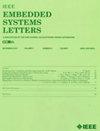我们是否应该优化执行能量?重新思考MAGIC设计风格的映射
IF 1.7
4区 计算机科学
Q3 COMPUTER SCIENCE, HARDWARE & ARCHITECTURE
引用次数: 3
摘要
在传统的数据密集型计算中,基于忆阻器的内存逻辑(LiM)作为克服冯·诺依曼瓶颈的一种手段而受到欢迎。最近,忆阻器辅助逻辑(MAGIC)设计风格因其简单性而获得了巨大的吸引力。然而,了解记忆存储器中逻辑运算设计过程中的能量分布对于评估这种实现的意义至关重要。目前的能量估计方法依赖于粗粒度技术,低估了在忆阻器横条上执行的magic式操作的能量消耗。为了解决这个问题,我们分析了MAGIC操作中的能量分解,并提出了一种解决方案,利用simple MAGIC工具的映射,通过SPICE模拟实现准确的能量估计。与现有主要关注优化执行能量的研究相反,我们的研究结果表明,MAGIC设计风格的忆阻器初始化能量平均高出68倍。我们证明了这个初始化能量显著地支配着总能量消耗。通过强调这方面,我们的目标是将设计人员的注意力转移到开发算法和策略上,这些算法和策略优先考虑初始化中的优化,而不是执行更有效的节能。本文章由计算机程序翻译,如有差异,请以英文原文为准。
Should We Even Optimize for Execution Energy? Rethinking Mapping for MAGIC Design Style
Memristor-based logic-in-memory (LiM) has become popular as a means to overcome the von Neumann bottleneck in traditional data-intensive computing. Recently, the memristor-aided logic (MAGIC) design style has gained immense traction for LiM due to its simplicity. However, understanding the energy distribution during the design of logic operations within the memristive memory is crucial in assessing such an implementation’s significance. The current energy estimation methods rely on coarse-grained techniques, which underestimate the energy consumption of MAGIC-styled operations performed on a memristor crossbar. To address this issue, we analyze the energy breakdown in MAGIC operations and propose a solution that utilizes mapping from the SIMPLER MAGIC tool to achieve accurate energy estimation through SPICE simulations. In contrast to existing research that primarily focuses on optimizing execution energy, our findings reveal that the memristor’s initialization energy in the MAGIC design style is, on average,
$68\times $
higher. We demonstrate that this initialization energy significantly dominates the overall energy consumption. By highlighting this aspect, we aim to redirect the attention of designers toward developing algorithms and strategies that prioritize optimizations in initializations rather than execution for more effective energy savings.
求助全文
通过发布文献求助,成功后即可免费获取论文全文。
去求助
来源期刊

IEEE Embedded Systems Letters
Engineering-Control and Systems Engineering
CiteScore
3.30
自引率
0.00%
发文量
65
期刊介绍:
The IEEE Embedded Systems Letters (ESL), provides a forum for rapid dissemination of latest technical advances in embedded systems and related areas in embedded software. The emphasis is on models, methods, and tools that ensure secure, correct, efficient and robust design of embedded systems and their applications.
 求助内容:
求助内容: 应助结果提醒方式:
应助结果提醒方式:


